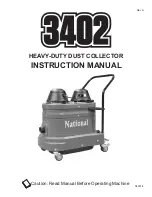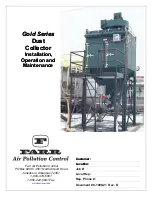
Safety
www.nationalequipment.com
Phone: 763-315-5300
5
GENERAL RULES FOR SAFE OPERATION
READ AND SAVE ALL INSTRUCTIONS FOR FUTURE USE:
Before use, be sure everyone operating this equipment reads and
understands this manual as well as any labels packaged with or attached to the tool.
1. KNOW
YOUR
EQUIPMENT:
Read this manual carefully to learn equipment applications and limitations as well as potential hazards
associated with this type of equipment.
2. GROUND
YOUR
TOOL:
See Grounding (See Page 7).
3. AVOID DANGEROUS ENVIRONMENTS:
Do not use in rain, damp or wet locations, or in the presence of explosive atmospheres
(gaseous fumes, dust or fl ammable materials). Remove materials or debris that may be ignited by sparks.
4. KEEP WORK AREA CLEAN AND WELL LIT:
Cluttered, dark work areas invite accidents.
5. DO NOT USE ON STEPS.
6. DRESS
PROPERLY:
Do not wear loose clothing.
7. USE SAFETY EQUIPMENT:
Everyone in the work area should wear safety goggles or glasses complying with current safety stan-
dards. Wear hearing protection during extended use and a dust mask for dusty operations.
8. KEEP
BYSTANDERS
AWAY:
Children and bystanders should be kept at a safe distance from the work area to avoid distracting the
operator and contacting the tool or extension cord. Operator should be aware of who is around them and their proximity.
9. PROTECT OTHERS IN THE WORK AREA:
Provide barriers or shields as needed to protect others from debris.
10. USE PROPER ACCESSORIES:
Using accessories that are not recommended may be hazardous. Be sure accessories are prop-
erly installed and maintained.
11. CHECK FOR DAMAGED PARTS:
Inspect guards and other parts before use. Check for misalignment, binding of moving parts,
improper mounting, broken parts and any other conditions that may affect operation. If abnormal noise or vibration occurs, turn the tool
off immediately and have the problem corrected before further use. Do not use damaged equipment. Tag damaged tools “DO NOT USE”
until repaired. A guard or other damaged parts should be properly repaired or replaced. For all repairs, insist on only identical National
replacement parts.
12. REMOVE ALL ADJUSTING KEYS AND WRENCHES:
Make a habit of checking that the adjusting keys, wrenches, etc. are
removed from the tool before turning it on.
13. GUARD AGAINST ELECTRIC SHOCK:
Prevent body contact with grounded surfaces such as pipes, radiators, ranges and
refrigerators. Before use always check the work area for hidden wires or pipes. Use a Ground Fault Circuit Interrupter (GFCI) to reduce
shock hazards.
14. AVOID ACCIDENTAL STARTING:
Be sure equipment is turned off before plugging it in. Do not use a tool if the power switch does
not turn the tool on and off.
15. DO NOT ABUSE CORD:
Never unplug by pulling the cord from the outlet. Pull plug rather than cord to reduce the risk of damage.
Keep the cord away from heat, oil, sharp objects, cutting edges and moving parts.
16. STAY ALERT:
Watch what you are doing, and use common sense. Do not use when you are tired, distracted or under the infl uence of
drugs, alcohol or any medication causing decreased control.
17. STARTING MACHINE:
On/off switch must be in off position before connecting to power source.
18. DO NOT DEFEAT OR ALTER A SWITCH OR SAFETY DEVICE
19. UNPLUG EQUIPMENT:
When it is not in use, unplug tool before changing accessories or performing recommended maintenance.
20. MAINTAIN EQUIPMENT CAREFULLY:
Keep handles dry, clean and free from oil and grease. Periodically inspect tool cords and
extension cords for damage. Have damaged parts repaired or replaced.
Summary of Contents for 3402
Page 2: ......
Page 20: ...Parts List and Diagrams Fax 763 535 8255 info nationalequipment com 20...
Page 26: ......






















